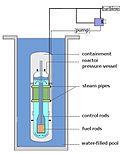Light-water reactor
Light-water reactor (LWR) is a type of thermal-neutron reactor that uses normal water, as opposed to heavy water, as both its coolant and neutron moderator. This distinguishes it from other types of nuclear reactors such as heavy water reactors, graphite-moderated reactors, or fast neutron reactors. LWRs are the most common type of nuclear reactor in use for power generation today.
History[edit]
The concept of the light-water reactor was first proposed in the United States in the early 1950s. The United States Navy was the first to use LWRs for its nuclear submarines, with the launch of the USS Nautilus (SSN-571) in 1954. The success of this project led to the development of commercial LWRs for power generation.
Design and operation[edit]
The design of a light-water reactor is characterized by its use of light water (ordinary water) as both a coolant and a neutron moderator. This dual role allows the reactor to maintain a stable and self-sustaining nuclear chain reaction.
The core of an LWR contains fuel rods made up of uranium or plutonium that undergo nuclear fission when struck by a neutron. The heat generated by this process is transferred to the water, which is circulated through the reactor core. The heated water then travels to a steam generator, where it transfers its heat to a secondary loop of water. This secondary water loop turns into steam, which drives a turbine connected to an electric generator.
Types of light-water reactors[edit]
There are two main types of light-water reactors: the pressurized water reactor (PWR) and the boiling water reactor (BWR).
Pressurized water reactor[edit]
In a pressurized water reactor, the water in the reactor core is kept under high pressure to prevent it from boiling. The heated water from the reactor core is sent to a steam generator, where it heats a separate loop of water into steam. The steam then drives a turbine to generate electricity.
Boiling water reactor[edit]
In a boiling water reactor, the water in the reactor core is allowed to boil into steam. This steam is directly used to drive a turbine to generate electricity.
Safety and environmental considerations[edit]
Light-water reactors are designed with multiple safety systems to prevent nuclear meltdown and the release of radioactive material. However, accidents such as the Three Mile Island accident and the Fukushima Daiichi nuclear disaster have raised concerns about the safety of LWRs.
From an environmental perspective, LWRs produce no greenhouse gas emissions during operation. However, the mining and enrichment of uranium, as well as the disposal of nuclear waste, do have environmental impacts.
See also[edit]

This article is a nuclear physics or atomic physics–related stub. You can help WikiMD by expanding it!
Light-water_reactor[edit]
-
Pumpless light water reactor
-
Koeberg Nuclear Power Station
-
Reactor Vessel Head
-
Fuel Pellet
-
Pellet Rod
Ad. Transform your life with W8MD's Budget GLP-1 injections from $75


W8MD offers a medical weight loss program to lose weight in Philadelphia. Our physician-supervised medical weight loss provides:
- Weight loss injections in NYC (generic and brand names):
- Zepbound / Mounjaro, Wegovy / Ozempic, Saxenda
- Most insurances accepted or discounted self-pay rates. We will obtain insurance prior authorizations if needed.
- Generic GLP1 weight loss injections from $75 for the starting dose.
- Also offer prescription weight loss medications including Phentermine, Qsymia, Diethylpropion, Contrave etc.
NYC weight loss doctor appointmentsNYC weight loss doctor appointments
Start your NYC weight loss journey today at our NYC medical weight loss and Philadelphia medical weight loss clinics.
- Call 718-946-5500 to lose weight in NYC or for medical weight loss in Philadelphia 215-676-2334.
- Tags:NYC medical weight loss, Philadelphia lose weight Zepbound NYC, Budget GLP1 weight loss injections, Wegovy Philadelphia, Wegovy NYC, Philadelphia medical weight loss, Brookly weight loss and Wegovy NYC
|
WikiMD's Wellness Encyclopedia |
| Let Food Be Thy Medicine Medicine Thy Food - Hippocrates |
Medical Disclaimer: WikiMD is not a substitute for professional medical advice. The information on WikiMD is provided as an information resource only, may be incorrect, outdated or misleading, and is not to be used or relied on for any diagnostic or treatment purposes. Please consult your health care provider before making any healthcare decisions or for guidance about a specific medical condition. WikiMD expressly disclaims responsibility, and shall have no liability, for any damages, loss, injury, or liability whatsoever suffered as a result of your reliance on the information contained in this site. By visiting this site you agree to the foregoing terms and conditions, which may from time to time be changed or supplemented by WikiMD. If you do not agree to the foregoing terms and conditions, you should not enter or use this site. See full disclaimer.
Credits:Most images are courtesy of Wikimedia commons, and templates, categories Wikipedia, licensed under CC BY SA or similar.
Translate this page: - East Asian
中文,
日本,
한국어,
South Asian
हिन्दी,
தமிழ்,
తెలుగు,
Urdu,
ಕನ್ನಡ,
Southeast Asian
Indonesian,
Vietnamese,
Thai,
မြန်မာဘာသာ,
বাংলা
European
español,
Deutsch,
français,
Greek,
português do Brasil,
polski,
română,
русский,
Nederlands,
norsk,
svenska,
suomi,
Italian
Middle Eastern & African
عربى,
Turkish,
Persian,
Hebrew,
Afrikaans,
isiZulu,
Kiswahili,
Other
Bulgarian,
Hungarian,
Czech,
Swedish,
മലയാളം,
मराठी,
ਪੰਜਾਬੀ,
ગુજરાતી,
Portuguese,
Ukrainian




